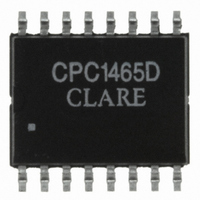CPC1465D Clare, CPC1465D Datasheet - Page 10

CPC1465D
Manufacturer Part Number
CPC1465D
Description
IC DC TERMINATION 16-SOIC
Manufacturer
Clare
Datasheet
1.CPC1465DTR.pdf
(15 pages)
Specifications of CPC1465D
Function
DC Signal Termination
Interface
ISDN, SHDSL
Number Of Circuits
1
Power (watts)
1W
Operating Temperature
-40°C ~ 85°C
Mounting Type
Surface Mount
Package / Case
16-SOIC
Includes
Optocoupler
Lead Free Status / RoHS Status
Lead free / RoHS Compliant
Current - Supply
-
Voltage - Supply
-
Lead Free Status / Rohs Status
Compliant
Other names
CLA206
CPC1465D
CPC1465D
Available stocks
Company
Part Number
Manufacturer
Quantity
Price
Part Number:
CPC1465D
Manufacturer:
CPCLARE
Quantity:
20 000
Company:
Part Number:
CPC1465DTR
Manufacturer:
PHI
Quantity:
3 000
Part Number:
CPC1465DTR
Manufacturer:
CLARE
Quantity:
20 000
CPC1465
2. Functional Description
2.1 Introduction
The CPC1465 can be used for a number of designs
requiring a dc hold circuit such as SHDSL modem and
ISDN NT1 terminal applications. Typical SHDSL
applications will use a circuit design similar to the one
shown in Figure 10‚ “Typical ISDN NT1 Application
Diagram” on page 9 while the typical ISDN NT1 circuit
design will be similar to the one shown in Figure 10‚
“Typical ISDN NT1 Application Diagram” on page 9.
The DC Termination IC performs two functions in an
ISDN NT1 terminal; as an electronic inductor providing
a low impedance dc termination with a high
impedance ac termination, and second as part of the
dc signalling system for automated line testing
capability. The CPC1465 meets or exceeds the
requirements for an NT1 dc termination as described
in ANSI T1.601-1991.
Whereas the SHDSL modem application does not
have a signalling requirement, the signaling function
provides an excellent method to monitor for the loss of
sealing current. Generally, loss of sealing current in an
SHDSL application indicates loop loss.
As can be seen in the application circuit in Figure 1 on
page 1, CPC1465 designs require few external
components. For the most basic design, all that is
needed is a circuit protector, two resistors and a
capacitor.
2.2 Surge Protection
Although the CPC1465 is current limited, it is not an
over-voltage surge protector. To protect the CPC1465
against destructive over-voltage transients, Clare
recommends the use of a crowbar-type surge
protector that limits the surge voltage seen by the
CPC1465 to 250 V. The protection device must be
able to withstand the surge requirements specified by
the appropriate governing agency in regions where
the product will be deployed. Teccor, Inc. and Bourns,
Inc. make suitable surge protectors for most
applications. Devices such as Teccor’s P1800SC or
P2000SC Sidactors and Bourns’ TISP4220H3 or
TISP4240H3 thyristors should provide suitable
protection.
2.3 Bridge Rectifier
The bridge rectifier in the CPC1465 ensures that the
device is polarity insensitive and provides consistent
10
www.clare.com
operational characteristics if the tip and ring leads are
reversed.
2.4 State Transitions
The dc tip to ring voltage-current characteristics of the
CPC1465 are shown in Figure 2‚ “I-V Requirements
Template, 0 V to 50 V”, and in Figure 3‚ “I-V
Requirements Template, 0 V to 250 V” on page 5.
Transition timings are illustrated in Figure 7‚ “Applied
Waveform for Activation Test”, and in Figure 8‚
“Applied Waveform for Deactivation Test”. The test
configuration for these timings is given in Figure 6‚
“Test Circuit for Activate and Deactivate Times”. All
timing figures are located on page 7.
State transition timings are set by the 1 μF capacitor
connected between the TC and COM pins.
2.4.1 Activation - On-State
Application of battery voltage to the loop causes the
CPC1465 to conduct whenever the voltage exceeds
approximately 35 V. With application of sufficient
voltage applied across the tip and ring terminals, the
CPC1465 will initially conduct a nominal 150 μA of
sealing current for approximately 20 ms prior to
activation. Once activated, the CPC1465 will remain in
the on state for as long as the loop current exceeds a
nominal 0.5 mA.
The CPC1465 turn-on timing circuit assures device
activation will occur within 50 ms of an applied voltage
greater than 43.5 V but not within the first 3 ms.
2.4.2 Deactivation - Off-State
While the CPC1465 activation protocol is based on an
initial minimum voltage level, deactivation is based on
a diminished sealing current level. Deactivation occurs
when the nominal sealing current level drops below
0.5 mA with guaranteed deactivation occurring for
sealing current levels less than 0.1 mA
The turn-off timing circuit deactivates the sealing
current hold circuit when 1 mA of sealing current has
been removed for 100 ms but ignores periods of loss
up to 3 ms.
R02


















